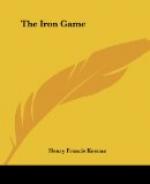“Here,” he said, “is the Bull Run. It makes two big elbows eastward toward us—one about four miles to the northwest of us, the other about eight miles to the southeast of that, and about four miles from our right hand here! The rebel we quizzed yesterday says that there are five fords between the Warrenton pike bridge—that’s just ahead of us yonder at the end of the road we are on—the last one is McLean’s Ford, at the very knuckle of the elbow that is crooked toward us a mile west of where we were yesterday. That is near the railway, which it is Beauregard’s business to fight for and our business to get, for then he will have to fall back near Richmond to feed his army. Now from the railway where it crosses Bull Run near Mitchell’s Ford to the Warrenton road, which Beauregard must also hold, is about nine miles. He must guard all these fords, and we must fight for any one or two of them that we need to cross by. The only problem is, whether our general is going to strike with his right arm at Mitchell’s Ford, his left arm at this very Warrenton road we are on, or whether he means to butt the middle of the line of Beauregard’s battle to break him into two pieces?”
“What would Frederick the Great or Napoleon do?” Nick asked, absorbed in Jack’s confident predications.
“If Frederick had equal forces he would have a reserve just where we shall be in the morning—there at that point marked ‘Stone Ridge,’ and move a heavy mass to the southwest below McLean’s Ford there, where you see the railway runs along the run for a half-mile or more. Or he would send this body to the northeast, over there where you see Sudley Springs marked in rather large letters, and he would by either one of these movements turn the enemy’s flank—that is, get in behind him and force him to change front to fight, something that is rarely done successfully in battle. Napoleon would, on the contrary, mass all his best troops at the stone bridge, open the fight with every piece of artillery he could bring to bear, and in the panic send divisions ten deep across the bridge.”
“Which would be the better plan?”
“Ah! that no one can say. The first is sure enough and less dangerous, if the commander is not certain of his men, because you notice that we felt excellent and confident all day, so long as we were marching forward and pushing the enemy from our path. The trial in battle is to be kept standing under fire, not sure where your enemy is; and then you noticed that our own guns behind us, sending shot and shells over us, were just as trying as the rebels’. Only soldiers of the very first class can be depended on in the Napoleon tactics. We are not soldiers of the first class; and you may be sure McDowell, who was many years in Europe, and who is a trained officer, will make use of the manoeuvres best calculated to bring out whatever there is in his men. As a matter of opinion, I should say that, in view of the miserable affair on the right yesterday, he will strike out for Sudley Springs, where we shall have the rebels just as you would have me if you were at my side, held my left arm behind me, ready to break my back with your knee planted in it.”




